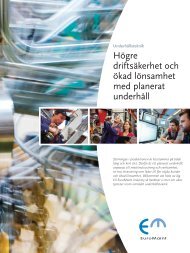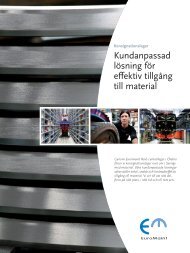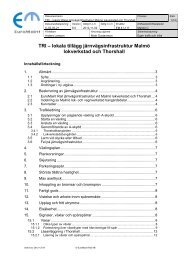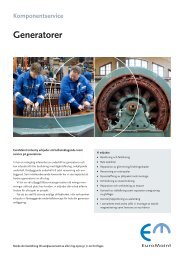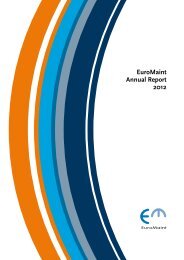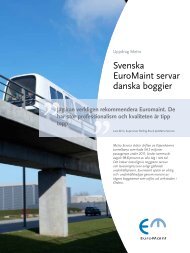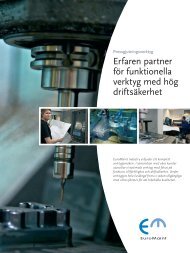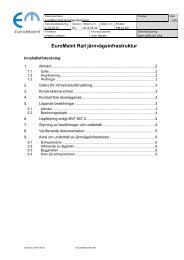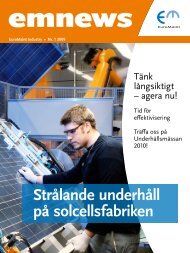Annual Report 2006 (pdf) - EuroMaint Rail
Annual Report 2006 (pdf) - EuroMaint Rail
Annual Report 2006 (pdf) - EuroMaint Rail
You also want an ePaper? Increase the reach of your titles
YUMPU automatically turns print PDFs into web optimized ePapers that Google loves.
E u r o M a i n t A n n u a l R e p o r t 2 0 0 6<br />
Notes<br />
Note 1<br />
Accounting principles Contd.<br />
The ITP pension, which is secured through an insurance policy with<br />
Alecta, is therefore entered as a defined contribution plan. Fees for<br />
the year for pension plans issued by Alecta amount to SEK 15 (19)<br />
million. Some employees are entitled to exchange part of their ITP<br />
plan for a premium-based pension solution where the company’s sole<br />
obligation is to pay the set premiums. The fees are reported as costs of<br />
personnel when they fall due for payment. Prepaid fees are recognised<br />
as an asset to the extent that cash repayment or a reduction in future<br />
payments may accrue to the company.<br />
A defined benefit pension plan guarantees the employee a pension<br />
equivalent to a certain percentage of his or her final salary. The liability<br />
recognised in the balance sheet regarding defined benefit pension<br />
plans is the present value of the defined benefit obligation on the balance<br />
sheet date net the fair value of the plan assets, with adjustments<br />
for unrecognised actuarial gains/losses for past service. The defined<br />
benefit pension obligation is calculated annually by independent<br />
actuaries.<br />
The present value of the defined benefit obligation is established<br />
by discounting the estimated future cash flow at an interest rate<br />
for government bonds issued in the same currency in which the<br />
remuneration will be paid out, and with durations comparable to the<br />
pension provision in question. Actuarial gains and losses arising from<br />
experience-based adjustments and changes in actuarial assumptions<br />
exceeding the higher of 10% of the value of the plan assets and 10%<br />
of the defined benefit obligation, are taken up as expense or revenues<br />
over the estimated average remaining period of service of the employees.<br />
Past service cost is recognised directly in the income statement,<br />
unless the changes in the pension plan are conditional on the employee<br />
remaining in service for a set period (entitlement period). In such<br />
cases, the past service cost is recognised on a straight-line basis over<br />
the entitlement period.<br />
Remuneration on termination of employment<br />
Remuneration on termination of employment is paid when an<br />
employee’s position is terminated prior to standard retirement or<br />
when an employee accepts voluntary redundancy from the position in<br />
exchange for such remuneration. The Group recognises severance pay<br />
when it is demonstrably obliged either to make the employee redundant<br />
in accordance with a detailed formal plan with no opportunity for<br />
recall, or to provide remuneration upon redundancy due to an offer<br />
made to encourage voluntary redundancy among personnel. Benefits<br />
due after 12 months of the balance sheet date or longer are discounted<br />
at the present value.<br />
Provisions<br />
Provisions are recognised when the Group has an existing legal or<br />
constructive obligation as a result of a past event, and it is more<br />
probable than not that an outflow of resources will be required to<br />
settle the obligation, and the amount has been reliably estimated. No<br />
provisions are made for future operating losses. If there are a number<br />
of similar obligations, the probability that an outflow of resources<br />
will be required to settle is assessed generally for this entire group<br />
of obligations. A provision is also reported if the probability of an<br />
outflow regarding a specific item in this group of commitments is<br />
only slight.<br />
Revenue recognition<br />
Net turnover encompasses sales of services and goods within maintenance,<br />
new construction and refurbishment of rolling stock, as well<br />
as maintenance and implementation of production facilities for the<br />
engineering industry.<br />
For maintenance contracts guaranteeing availability, known as<br />
‘TSC contracts’ (Total Service Concept), and new construction and<br />
refurbishment contracts, revenues and costs pertaining to the<br />
assignment are recognised relative to the degree of completion of the<br />
assignment. This accounting principle is based on the view that the<br />
task is fulfilled in line with the work being carried out, and means that<br />
profit is recognised progressively based on the degree of completion<br />
of each assignment when the assignment’s final outcome can be<br />
measured in a reliable way. For availability contracts, the degree of<br />
completion is determined on the basis of work carried out in relation<br />
to the maintenance plan. For new construction and refurbishment<br />
contracts, the degree of completion is determined in relation to<br />
accrued assignment costs. If an assignment’s final outcome cannot<br />
be measured in a reliable way but no loss is feared, revenue<br />
corresponding to accrued costs is recognised.<br />
A feared loss for an assignment is immediately charged in its<br />
entirety to the period’s results.<br />
Leases<br />
Leases where the risks and rewards of ownership are retained by the<br />
lessor are classified as operating leases. Payments made during the<br />
lease term are taken up as expenses in the income statement on a<br />
straight-line basis over the lease term.<br />
Cash flow analysis<br />
The indirect method is applied in recognising cash flow from<br />
operating activities.<br />
Related parties<br />
Related companies to the <strong>EuroMaint</strong> Group are defined as<br />
state companies with market requirements where the state has<br />
a controlling influence.<br />
Persons closely associated with the Group are defined as Board<br />
members, senior personnel and close family members of these<br />
people.<br />
Disclosures are provided about transactions with related parties<br />
which entail the transfer of resources, services or obligations between<br />
related parties, whether or not remuneration is paid. The information<br />
contains details of the nature of the relationship and information<br />
about the effect of the relationship on the financial reports.<br />
Parent company<br />
The parent company applies the same accounting principles as the<br />
Group, along with RR 32:05.<br />
52



